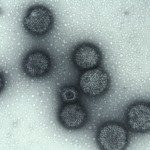Lien vers Pubmed [PMID] – 24379445
Mol. Cell Proteomics 2014 Mar;13(3):716-32
Bacillus anthracis is the causative bacteria of anthrax, an acute and often fatal disease in humans. The infectious agent, the spore, represents a real bioterrorism threat and its specific identification is crucial. However, because of the high genomic relatedness within the Bacillus cereus group, it is still a real challenge to identify B. anthracis spores confidently. Mass spectrometry-based tools represent a powerful approach to the efficient discovery and identification of such protein markers. Here we undertook comparative proteomics analyses of Bacillus anthracis, cereus and thuringiensis spores to identify proteoforms unique to B. anthracis. The marker discovery pipeline developed combined peptide- and protein-centric approaches using liquid chromatography coupled to tandem mass spectrometry experiments using a high resolution/high mass accuracy LTQ-Orbitrap instrument. By combining these data with those from complementary bioinformatics approaches, we were able to highlight a dozen novel proteins consistently observed across all the investigated B. anthracis spores while being absent in B. cereus/thuringiensis spores. To further demonstrate the relevance of these markers and their strict specificity to B. anthracis, the number of strains studied was extended to 55, by including closely related strains such as B. thuringiensis 9727, and above all the B. cereus biovar anthracis CI, CA strains that possess pXO1- and pXO2-like plasmids. Under these conditions, the combination of proteomics and genomics approaches confirms the pertinence of 11 markers. Genes encoding these 11 markers are located on the chromosome, which provides additional targets complementary to the commonly used plasmid-encoded markers. Last but not least, we also report the development of a targeted liquid chromatography coupled to tandem mass spectrometry method involving the selection reaction monitoring mode for the monitoring of the 4 most suitable protein markers. Within a proof-of-concept study, we demonstrate the value of this approach for the further high throughput and specific detection of B. anthracis spores within complex samples.


